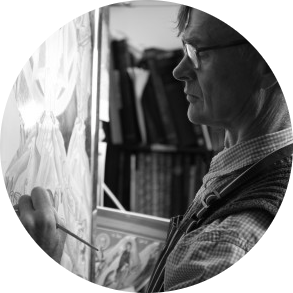Interviewer: Did (iconographer Photios) Kontoglou ever make a distinction between the so-called “big–T Tradition and small–t tradition”? Such a view states that there are some traditions in the realm of dogma, doctrine, and spirituality that are absolutely non-negotiable, but there are smaller traditions like beards and rassa that are negotiable. You don’t have to have them, but you may have them. Did he ever make any distinctions like that?
Fr. Constantine Cavarnos, iconographer & Schemamonk: He did not make such a distinction. He believed that innumerable things organically related make Orthodoxy and give it its identity.
Everything is organically related. About the Church’s arts, for example… iconography addresses itself to our sense of sight, while music addresses itself to our sense of hearing, but both seek to express the same essence, the Orthodox Faith. Architecture has its own tradition, particularly recognizable in the dome, in the round arch, and by the surfaces that are used for the wall paintings, which other kinds of architecture, such as the Gothic, do not provide. The architecture of the Orthodox church is a very important element of the totality; in other words, all of these arts are organically interrelated, though using different media.
Iconography, hymnody, music, and architecture of the Byzantine tradition are trying to convey the same thing. They have the same point of origin: they all spring from and are used to communicate the Orthodox Faith and make it apprehensible to the believer through the senses. Thus, you can see the organic unity of the fine arts of Orthodoxy. You can also see it in the appearance of the priest, the monk, the form of the prayers, and the Liturgy. All of these things are organically related to one another.
If you say that traditional iconography is not essential, or the traditional music is secondary and can be replaced with organs or violins, while still retaining Orthodoxy—that’s not so! When you eliminate these things, what’s left? Soon you’ll begin toning down the dogmas because of minimalism or relativism. The Greeks have a word for this: xephtisma, unravelment. Your pants are torn in one place, you let that go, then the tear spreads out. If you don’t patch it up in time, it will spread more and more, and the whole garment then falls to pieces. So you have to mend it. If you don’t take the time to repair any kind of break from the Tradition, then the whole thing begins to fall apart. And that’s what has happened to much of the Orthodox world. It’s falling apart in this way, saying: This does not matter, that is not essential, that’s unimportant, that’s a convention, and so forth.”
– Fr. Constantine Cavarnos, Hieroschemamonk
Unwavering Fidelity to Holy Tradition
Featured image: From the cover of one of several books written by Cavarnos



